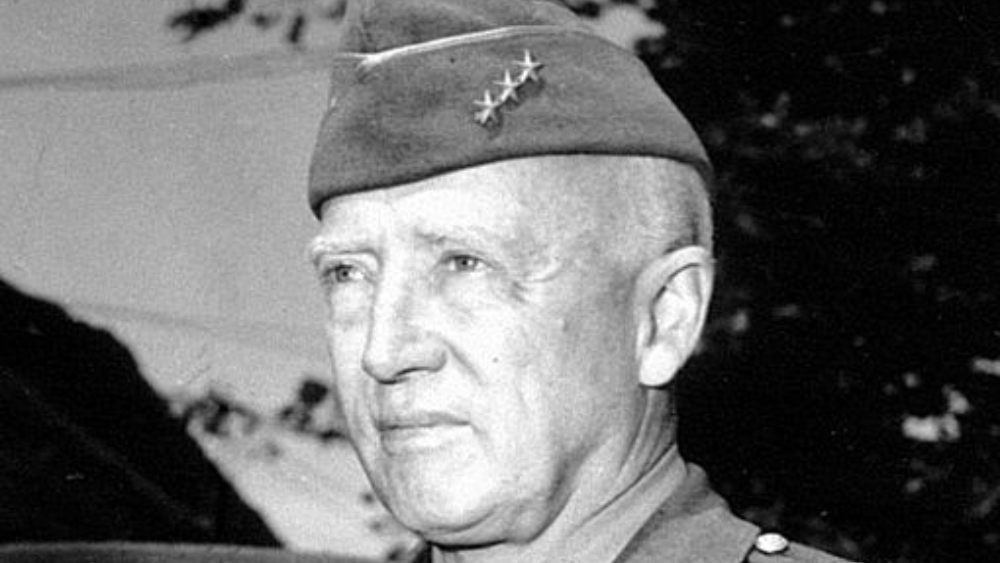George S. Patton Jr. says, “No good decision was ever made in a swivel chair.”
At 5:55 p.m., General George S. Patton Jr. died peacefully on December 21, 1945. One of America’s best combat leaders perished when a blood clot in his immobilized body reached his heart.
The U.S. 7th Army, under the leadership of the World War II commander, invaded Sicily, while the U.S. 3rd Army crossed France following the assault of Normandy. The charismatic leader’s persistence earned him the nickname “Old Blood and Guts” from his soldiers. Nevertheless, there is more to the nickname’s origin than that.
Inside the Life of George S. Patton Jr.
One of World War II’s most well-known and successful American generals, George S. Patton Jr., was born into a proud military family. His men respected a brilliant combat commander and an entertaining and charismatic leader, Patton, for his strong resolve. Patton commanded American forces in WWII to resounding wins in the European plains, Sicilian farms, and North African deserts. It is through a succession of skillful battles. Ironically, this great warrior battled in two global wars. He emerged victorious, only to pass away in a car accident at the height of his success.
Modern views suggest that he struggled with spelling as a youngster and started to read late, indicating a sort of dyslexia. Patton participated in the modern pentathlon for the U.S. in the 1912 Summer Games in Stockholm after receiving his West Point diploma. He came in fifth. From a young age, he had an early interest in classical literature and military history but failed in elementary school with fundamental abilities, which plagued him throughout his subsequent military education.
Patton’s grandpa served in the Confederate Army during the American Civil War. After being born in San Gabriel, California, Patton attended West Point and Virginia Military Institute for his education. Patton had a hero and overall aspiration from an early age.
George S. Patton Jr. traveled to Europe with Pershing when the United States entered World War I in 1917, when he was appointed as the first officer of the newly formed U.S. Armor Corps. He quickly gained a reputation for his capacity for leadership and command in tank warfare. After the war, Patton served in numerous cavalry and tank groups at various American postings. He advanced to colonel by 1940 when the nation started to rearm.
The Death of a General
However, eight months into the peace, the general was not immune to a straightforward vehicle accident despite all his accomplishments. On December 9, 1945, only 12 days before he passed away, Patton was in the rear of his limousine when PFC Horace Woodring, the driver, drove through a railroad crossing in Manheim, Germany, and collided with an Army vehicle that was turning left and heading towards a depot. Through his quick conquest of Sicily, sprint through France, the rescue of Bastogne during the Battle of the Bulge, and advance into Germany, he decimated German troops, saved American lives, and caught the nation’s collective imagination.
The 60-year-old general had lived an exciting life, participating in nearly all of the major American conflicts of the 20th century. His military career reached its pinnacle during World War II when he commanded corps and armies from North Africa to Sicily to the European continent. He frequently took the initiative and nearly always led his team to victory.
Patton was taken 12 miles away to the 130th Station Hospital in Heidelberg. He was given an x-ray there, which showed two crushed vertebrae. In other words, Patton had a fractured neck. In order to stabilize his neck, Patton spent the following 12 days in traction while occasionally having uncomfortable fishhooks inserted into his cheeks on each side of his upper jaw.
To be by his side and read him books and messages from well-wishers, Beatrice, his wife, traveled in from Boston. His physicians put him in a body cast when he showed improvement to prepare him for travel back to the United States. Unfortunately, before the action could be taken, he gave in to his paralysis and passed away.
George S. Patton Jr. during World War I
General Pershing raised Patton to the rank of captain at the outset of American involvement in WWI in 1917. While in France, Patton requested a front-row seat. When the British Tank Corps won the Battle of Cambrai, he was deployed to the Panzer soldiers and the British Tank Corps. The employment of tanks as the primary fighting weapon occurred for the first time in this conflict.
Patton was elevated to lieutenant colonel and given command of the U.S. Tank Corps of the U.S. First Army. This is due to his accomplishments and the development of a tank crew training facility in Langres, France. He participated in the Meuse-Argonne Offensive between September 26 and November 11, 1918. Machine gun fire near the town of Cheppy injured Patton. He received a Purple Heart, a Distinguished Service Cross, and a promotion. This is the temporary rank of colonel for his involvement in World War I.
More of George S. Patton Jr.’s WWI Journey
With an iron grip, Patton dominated over his men, giving them the colorful moniker “Old Blood and Guts” because of his love for combat. The general led American troops back on the offensive after a string of setbacks and achieved the war’s first significant American victory over Nazi-led forces at the Battle of El Guettar in March 1943 with the help of this tremendous aggression and unyielding discipline.
Patton established a training facility in the California desert shortly after the Japanese attack on Pearl Harbor in December 1941. Then, he was assigned command of the 1st and 2nd Armored Divisions. Late in 1942, Patton led an American force into North Africa. Before the initial landings on Morocco’s Atlantic coast, he told his troops a statement that had become a part of military lore: “We shall attack until we are exhausted, and then we shall attack again.”
Shortly after this promise, he was appointed brigadier general of the newly formed armored brigade. Patton was promoted to major general when the brigade became part of the U.S. 2nd Armored Division. When the U.S. had not yet entered the conflict, and shortly after Germany’s Blitzkrieg in Western Europe, Patton persuaded Congress that the U.S. needed armored troops by citing, among other things, the German armored forces’ success in the French campaign.

Following a Battle and a Death
One day before Patton was scheduled to board a flight return to the U.S. in December 1945, his automobile collided with a lorry. In a Heidelberg hospital on December 21, 1945, Patton passed away from pulmonary edema and heart failure after being paralyzed from the neck down. Patton survived till the age of sixty. His remains were interred in the American War Cemetery in Hamm, a district of Luxembourg City, the Grand Duchy of Luxembourg’s capital, where supporters of the general continue to pay annual homage to him. Patton was given command of the 15th United States Army in the U.S. sector of Germany in October 1945.
Despite not having the spectacular battlefield death he desired, Patton received a hero’s burial in the U.S. Military Cemetery in Luxembourg’s Hamm. Charge d’Affaires George P. Waller provided the Department of State with the following report on the burial-associated issues.










